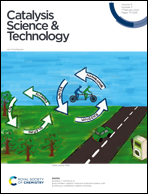Enhanced activity and sulfur resistance of Cu- and Fe-modified activated carbon for the reduction of NO by CO from regeneration gas†
Abstract
The reduction of NO by CO was proposed to be applied for regeneration gas to remove NOx from industrial flue gas with activated carbon purification technology. To improve the activity and sulfur resistance for the reduction of NO by CO in regeneration gas, Cu and Fe modifications on activated carbon were investigated. And various samples were characterized by XRD, XPS, TPD, H2-TPR, in situ DRIFTS and DFT calculations to explain the reaction mechanism and poisoning mechanism. The synergistic effects of oxygen-containing functional groups and metal sites show that –COOH acts as an anchor site for metals and that C–O–C acts as a protective site for Fe3+ under a SO2 atmosphere. Cu2+ sites have a high activity at low temperatures due to the large amount of adsorbed NO and the intermediate NOx− participating in the reaction with the NOx− pathway. Fe3+ sites have a high activity at high temperatures due to the high N–O dissociation activity with the *N pathway and –NCO pathway. DFT calculations proved that the binding Cu2+ and Fe3+ sites have higher activity than free Cu2+ and Fe3+ sites. A high content of SO2 exhibits various poisoning effects, mainly including the sulfation of metal sites, deposition of S, and consumption of CO. AC-Fe-H exhibits excellent resistance and stability against SO2 and H2O due to less S deposition caused by consumption through the S–CO reaction, slight sulfation caused by the protective effect of Fe2+ and C–O–C on Fe3+ sites and better hydrophobicity.



 Please wait while we load your content...
Please wait while we load your content...